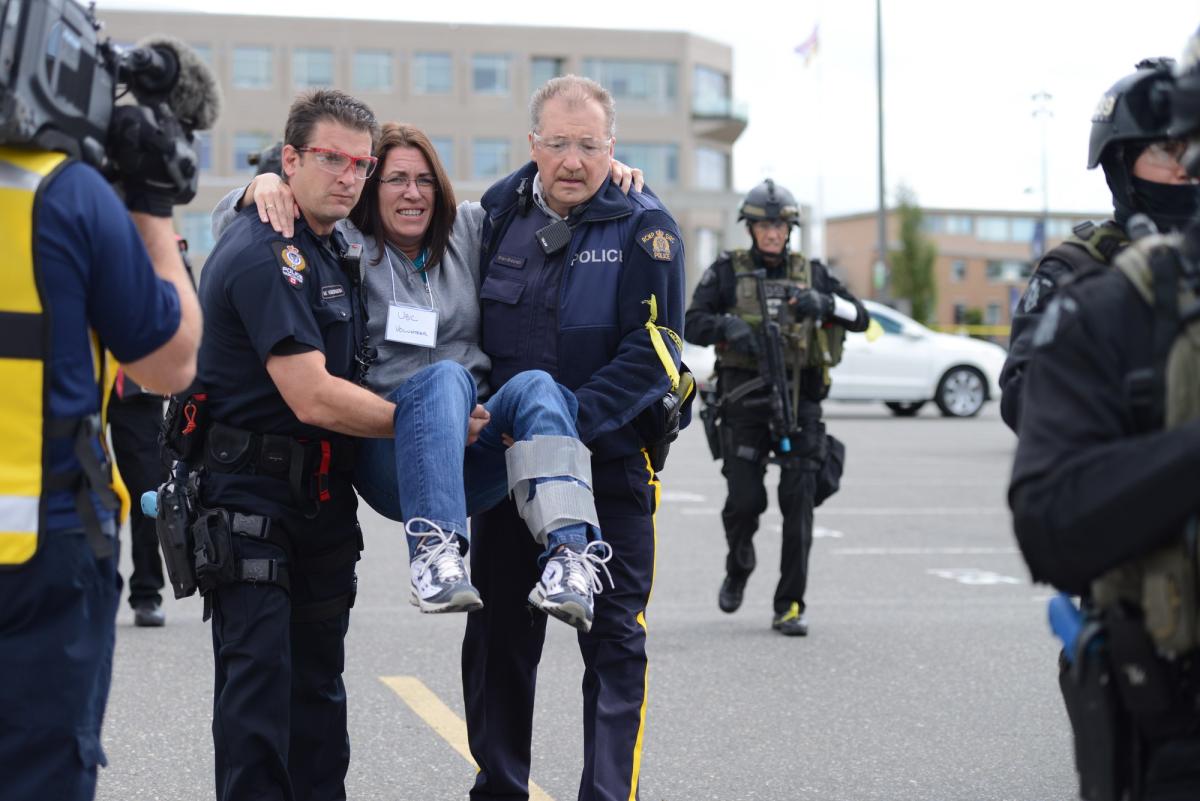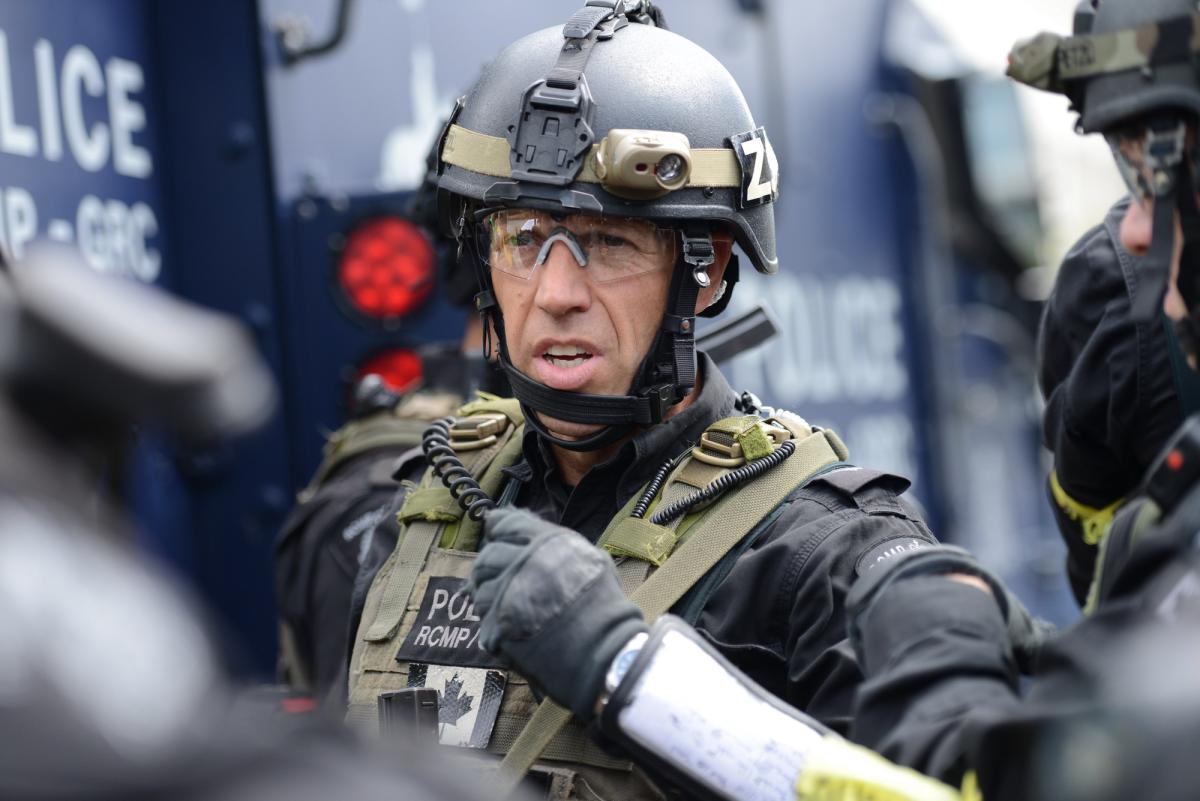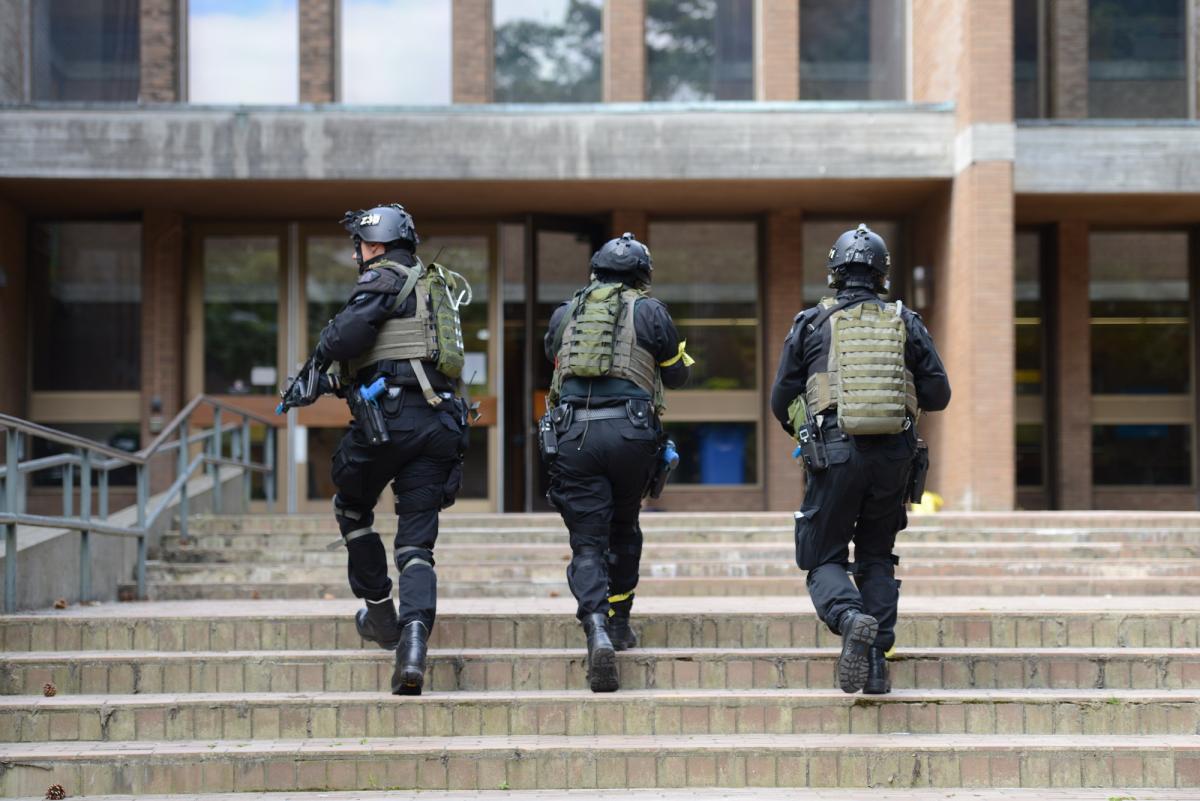Preparing for the Worst: Inside UBC’s campus shooter exercise
Shortly after nine on the morning of June 18, two heavily armed gunmen opened fire in the forestry building on UBC’s Vancouver campus.
The gunshots – thankfully simulated – set off one of the largest university emergency exercises in Canadian history, as police and administrators attempted to deal with the nightmare scenario of multiple gunmen on campus.
The dramatic exercise – the first of two large-scale simulations this year – is one example of how North America universities and colleges are incorporating the grim lessons of mass shootings at Virginia Tech University, Sandy Hook Elementary and Columbine High School to help prepare for future tragedies.
From earthquakes to chemical spills, universities have always faced a multitude of risks. But the growing threat of campus violence, particularly south of the border, paired with the rise of social media and the 24/7 online news cycle, have forced administrators to dramatically reboot their emergency planning, says Ron Holton, MBA’71, Chief Risk Officer and head of UBC Risk Management Services.
“Virginia Tech changed everything,” he says of the 2007 shooting that left 33 dead. “Before that, our focus was largely natural disaster preparation. But that incident – the violence, how fast it happened, and the intense scrutiny of the administration – that was the moment universities realized that we need to pay serious attention to the possibility of a shooter on campus.”
Worst-Case Scenario
Organized by the BC RCMP – which serves as primary responder in most real emergencies – the drill was the largest ever on a BC campus, approaching a scale not seen locally since emergency preparations for the Olympics (also led by Holton). Other participants included Vancouver Fire and Rescue, BC Ambulance Services, St. John’s Ambulance and the Vancouver Police Department.
Involving more than 300 staff from these agencies, the four-hour scenario unfolded in three buildings on south campus: Forest Sciences Centre, the H.R. MacMillan Building and Totem Park Residence. As gunmen moved from building to building, opening fire and taking hostages, police clashed with them repeatedly, practising the latest tactics in engagement, evacuation and hostage negotiation. Members of the Los Angeles Police Department – leading experts in this kind of situation – devised and attended the scenario. For training purposes, guns fired coloured chalk bullets and multimedia teams recorded the action.
Nearly 100 volunteers – students, alumni and staff – helped to keep first responders on their toes. Film industry make-up artists applied bullet wounds to be treated. When the shooting began, many volunteers started crawling and screaming as police tried carrying them outside for treatment. Others hid in classrooms and under desks to test police search and rescue skills.
“It was way more intense than I expected,” said Crystal Lei, a recent grad in Applied Science who played a hostage. “I was surprised how realistic it was. The gunshots were incredibly loud and the gunmen were dressed in black and were wearing these scary masks. My heartbeat was going like crazy.”
“With the lower gun ownership in Canada, I don’t really think about shootings at UBC,” added volunteer Ahmed Shahbaz, who is studying for his master’s in Mining Engineering. “But it is definitely reassuring that they are preparing for it. Some of my friends in India have avoided studying in the States because of things like Virginia Tech and the Colorado shooting.”
UBC’s Vancouver campus holds two major emergency preparedness exercises a year. These have been a mix of full scale simulations and “table-top exercises,” where UBC and first responders walk through how each would respond in a variety of worst-case situations: a plane crash, hazardous materials spills, bomb threats, earthquakes and fires.
According to Sgt. Peter Thiessen, spokesperson for the Lower Mainland RCMP, table-top exercises help to clarify roles, test procedures and identify areas for improvement. “They are important, but they can’t replace real world simulations,” he said, adding that UBC is one of the few universities in Canada with a dedicated RCMP detachment. “Simulations help us to practise our training, and test our equipment in a more realistic environment.”
UBC and its partners have clear roles in emergencies. Police, fire and ambulance tackle the threat and provide medical support. The university’s focus is keeping the rest of the campus safe by providing clear safety instructions as quickly as possible and working with authorities to determine which buildings to evacuate or sections of campus to close.
Credit for all photos: BC RCMP (click for larger images)
Emergencies in the Age of Social Media
During a campus crisis, UBC would activate its Emergency Operations Centre, where administrators from various areas – risk management, communications, operations, housing, finance – can monitor an emergency to inform key decisions.
Emergency communications is a major focus. “It could mean the difference between life and death,” Holton says, adding that UBC has significantly streamlined its emergency decision-making process to improve its communications abilities.
“This has resulted in an improvement in the frequency of messages we can send through our main emergency channels – the UBC homepage, the @UBCNews Twitter feed and campus digital signage,” he says. “With the rise of social media, and the speed that misinformation can spread, this was crucial for us.
In September, the university will also launch UBC ALERT, an emergency notification system that can blast safety instructions directly to subscribers’ cell phones by text or voice message. “With more than 60,000 people on UBC’s Vancouver campus on a typical day,” says Holton, “this new system has the potential to really improve our ability to communicate effectively in emergencies.
October ShakeOut
This October UBC will stage its largest earthquake exercise to date, with an extensive information campaign that will offer tips for surviving a major earthquake. And on October 17 at 10:17 in the morning, UBC community member will be asked to practise what they have learned.
“It may look ridiculous, but we are asking people to ‘drop, cover and hold on,’ whether they are strolling across campus or in the middle of a lab,” says Holton, referring to the recommended practice of getting under a desk – or best alternative – and holding on until the shaking stops. UBC ShakeOut will coincide with ShakeOut earthquake drills across BC.
As for next steps, Holton sees more real-world simulations and longer exercises. “Most of our exercises have gone for less than a day – but if something truly cataclysmic happened, we would need to make emergency decisions for 24 hours, 48 hours – maybe 72 hours or more,” he says. “So testing our staffing and systems for longer periods is something we plan to do very soon.”
“Parents around the world trust us to keep our students safe – and we take the responsibility extremely seriously,” says Holton. “You can never say you are 100 per cent ready for a catastrophic emergency, but we are doing everything we can to keep UBC as safe and secure as possible – and have strong systems in place for dealing with any emergencies that come our way.”
How to prepare for a disaster at UBC
Here are three steps every UBC student, staff and faculty member can take to prepare for a campus emergency:
Follow UBC channels: UBC’s website (ubc.ca), Twitter account (@UBCNews) and digital signage will provide regular updates during emergencies.
Subscribe to UBC ALERT: Sign up for UBC ALERT from the university’s new emergency text messaging system launching this fall. Visit emergency.ubc.ca/UBCalert to learn how to confirm your cell number.
Participate in UBC ShakeOUT: Take part in Canada’s largest earthquake preparedness exercise to learn the latest safety tips for surviving a major earthquake. Mark your calendars: October 17.
Learn more at emergency.ubc.ca.





































